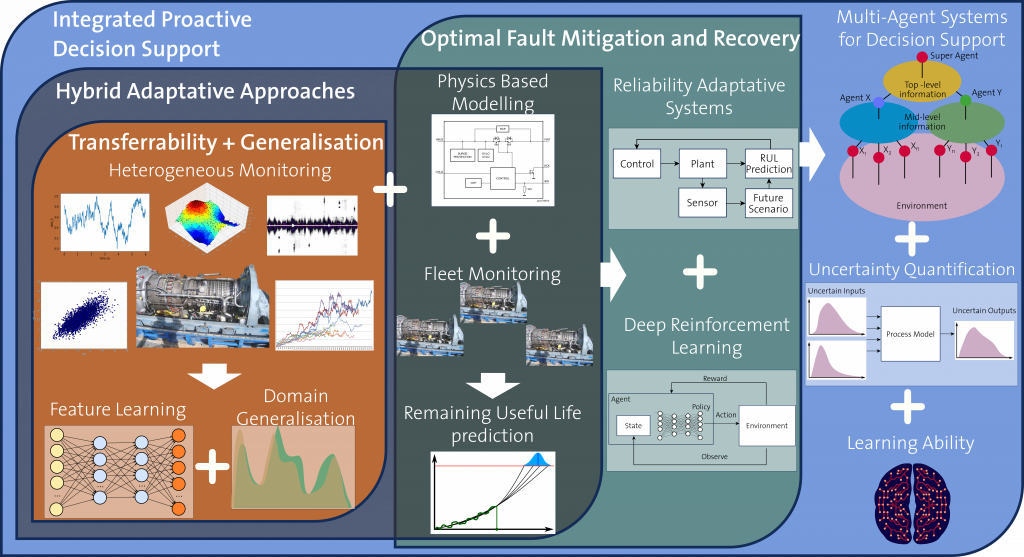Our research focuses on developing intelligent algorithms to improve performance, reliability and availability of complex industrial assets and making the maintenance more cost efficient.

Current Lab Research
Physics-informed graph neural networks (Pi-GNNs) are a powerful approach for modeling and analyzing complex systems in the context of industrial Internet of Things (IoT). These networks combine the capabilities of graph neural networks (GNNs) with the incorporation of physical laws and domain knowledge. By leveraging the graph structure of the system, Pi-GNNs can capture dependencies, interactions, and dynamics among different components in the industrial IoT networks (e.g., district heating networks, air pollution monitoring platforms, etc.). Additionally, the integration of physics-based constraints and equations allows Pi-GNNs to provide reliable and accurate predictions and enhance sensor validation.
Contact: Keivan Faghih Niresi
This project in collaboration with The Federal Institute of Metrology (METAS) aims to develop a procedure for the metrological validation or approval of digital methods for maintaining measurement stability in thermal energy networks in real time. To address the issue of detecting measurement drifts in thermal energy networks, a two-fold approach is necessary. Firstly, there is a need for the development of algorithms capable of identifying measurement drifts within these networks. Secondly, it is essential to validate the suitability of this proposed methodology on real data, as well as in laboratory setups. Additionally, digital twins of thermal energy networks must be developed to enable testing under controlled conditions. This comprehensive approach is expected to provide a reliable solution to the challenge of detecting measurement drifts in thermal energy networks.
Contact: Keivan Faghih Niresi
In collaboration with Swiss Federal Railways (SBB), this project focuses on enhancing the performance of state estimation and forecasting for unsupervised anomaly detection in the Swiss railway traction network using graph neural networks (GNNs). GNNs are particularly suitable for this purpose because they excel in capturing the intricate relationships within the interconnected railway traction grid, which can be naturally represented as a graph. The main objective of this project is to enhance GNN performance by incorporating physical laws and principles that govern electrical flow and energy conversion. Accurate estimation and forecasting of the traction grid’s state are crucial as they enable optimized energy management and anomaly detection in railway systems. By integrating anomaly detection algorithms into the central energy measurement system (EMS), operators can identify abnormal patterns or deviations from expected energy consumption and grid behavior. This ensures efficient operations, reduces energy costs, supports maintenance, and improves the service’s reliability, thereby minimizing disruptions and enhancing passenger satisfaction.
Contact: Raffael Pascal Theiler
This project is a collaboration between ETH Zurich, EPFL, Hitachi Energy, and BKW AG, and is supported by the Swiss Federal Office of Energy. The goal of this project is to perform condition monitoring on circuit breakers (CBs) as they make power transmission and distribution systems reliable and resilient. The project contains three steps: 1) perform mechanical run-to-failure experiments without current loads on different CB types and understand CB aging behaviors and then with current loads but not run-to-failure experiments in the laboratory 2) develop algorithms that are able to construct CB health indicators, detect fault conditions, and identify fault types 3) design IoT sensors and boards for data acquisition for continuous monitoring CBs in real substations in Switzerland. Ultimately, we will implement the developed CB condition monitoring algorithms on data taken in real substations by IoT sensors and boards.
Contact: Chi-Ching Hsu
This research project aims to develop a methodological framework for enabling reuse of steel structures under mechanical loading. This implies development of novel mechanics-based models for reliability predicting effects of natural ageing and work hardening on physical mechanisms causing loss of the load carrying capacity of steel structures over their service life. The above models will then be used in continuum finite element simulations of steel members to facilitate the development of physics-informed graph neural network algorithms for surrogate modelling for prognosticating the suitability of steel members for reuse in the development of a reliability based framework for limit state design of reclaimed steel members to meet risk-targeted performance criteria. This will enable increased value in a circular economy where end-of-life steel buildings could be de-constructable, and their reclaimed members could be blended into new builds with a high confidence.
Contact: Sergei Garmaev